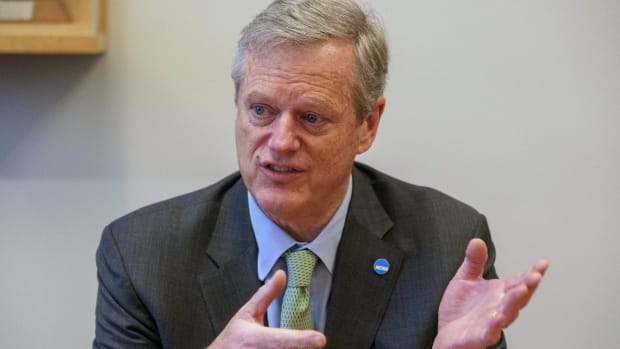Charlie Baker was hired as the NCAA president as much for what he isn’t as what he is. The primary things the former governor of Massachusetts is not: a product of the age-old bureaucratic machinery of the association, or its campus feeder system. Now we’re seeing the early impact of hiring an outsider.
After spending the beginning of this week bringing NCAA leadership groups up to speed, Baker and his staff Wednesday released a review of the state of the association’s business model. The conclusions show what fresh eyes can bring to an entrenched institution. There is an acknowledgement of problem areas and shortcomings, there are plans to enact internal changes and there are promises of more shifts to come.
This may stop short of a complete cultural overhaul. But since formally taking over as president March 1, Baker and his staff have run a five-month diagnostic test on the NCAA and decided on a course of corrective action.
In a report that declares “college sports are at a crossroads,” four pressure areas are identified: the decline of the college-age population and the rising cost of attendance, the increasing opportunities for young people to forego college altogether and get paid to play their sport, the impact upon athletes of social media and sports betting, and the “existential threat” to traditional media partners.
In addition to the omnipresent name, image and likeness issue, there are hot-button situations regarding realignment, rules enforcement, gambling, mental health, evolving fan habits of content consumption, unbundled NCAA championship broadcast contracts, emerging sports that could increase audiences and even a looming officiating shortage. The NCAA’s plate is large, and, as usual, it is full.
“To address these trends,” the report says, “the NCAA must have an operating model and mission that are explicit and understood by all. And there must be a more rigorous approach to business planning and follow through, with a new sense of urgency.”
Simply put, this crossroads moment is no time for a governing body with an identity crisis and slow reflexes. So there are some goals the report has articulated to get with the times in a timely fashion.
- “Develop a powerful, compelling case for change—clear articulation of both why ‘we can’t stay here’ and why it will be positive ‘to go there.’”
- “Focus and move quickly on things that matter—ruthlessly prioritize the few things that drive the majority of the value and accelerate results.”
- “Unleash potential of NCAA staff—use the transformation to find and empower the next leaders and to build the systems and capabilities needed for change.”
- “Increase the metabolic rate of the NCAA—use agile at scale/new ways of working to test and learn, fail quickly or succeed and scale.”
- “Be adaptable in program design—adjusting the program ‘roadmap’ for new competitive situations, opportunities, or market changes.”
“College sports remains in a period of dramatic transformation, and the NCAA must evolve in response to and anticipation of these changes,” Baker said in a statement. “We can no longer pretend things are as they always have been— and our new way of doing business will ready the national office to move forward with urgency, purpose and a plan. I believe the results of this review provide a compelling and detailed vision that every NCAA action should anchor to.”
Enacting major changes within the NCAA is not a new idea; quickly and effectively executing those changes has been the difficult part. This time, though, the association has imported an outsider who is untethered from the restraints that come with traditional NCAA thinking. Baker’s road map was drawn up from a fresh view of the terrain, which might help find the best path forward.


















